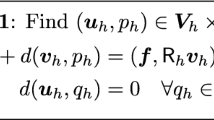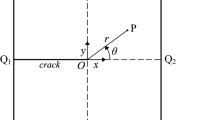Abstract
The virtual element method (VEM) is a recent technology that can make use of very general polygonal/polyhedral meshes without the need to integrate complex nonpolynomial functions on the elements and preserving an optimal order of convergence. In this article, the VEM is formulated and analyzed to solve the Brusselator model on polygonal meshes. Also an optimal a priori error estimate (under a small data assumption) is derived. Ample numerical experiments are performed to validate the accuracy and efficiency of the proposed scheme and to plot the Turing patterns of the Brusselator equation on a set of different computational meshes.















Similar content being viewed by others
References
Adomian, G.: The diffusion-Brusselator equation. Comput. Math. Appl. 29, 1–3 (1995)
Ang, W.-T.: The two-dimensional reaction-diffusion Brusselator system: a dual-reciprocity boundary element solution. Eng. Anal. Bound. Elem. 27, 897–903 (2003)
Beirão da Veiga, L., Lovadina, C., Vacca, G.: Virtual elements for the Navier-Stokes problem on polygonal meshes. SIAM J. Numer. Anal. 56, 1210–1242 (2018)
Beirão da Veiga, L., Russo, A., Vacca, G.: The virtual element method with curved edges, ESAIM. Math. Model. Numer. Anal. 53, 375–404 (2019)
Beirão da Veiga, L., Brezzi, F., Cangiani, A., Manzini, G., Marini, L.D., Russo, A.: Basic principles of virtual element methods. Math. Models Methods Appl. Sci. 23, 199–214 (2013)
Beirão da Veiga, L., Brezzi, F., Dassi, F., Marini, L.D., Russo, A.: Lowest order virtual element approximation of magnetostatic problems. Comput. Methods Appl. Mech. Eng. 332, 343–362 (2018)
Beirão da Veiga, L., Brezzi, F., Marini, L.D., Russo, A.: The Hitchhiker’s guide to the virtual element method. Math. Models Methods Appl. Sci. 24, 1541–1573 (2014)
Berrone, S., Borio, A., Manzini, G.: SUPG stabilization for the nonconforming virtual element method for advection-diffusion-reaction equations. Comput. Methods Appl. Mech. Eng. 340, 500–529 (2018)
Bertoluzza, S., Pennacchio, M., Prada, D.: BDDC and FETI-DP for the virtual element method. Calcolo 54, 1565–1593 (2017)
Brezzi, F., Marini, L.D.: Virtual element methods for plate bending problems. Comput. Methods Appl. Mech. Eng. 253, 455–462 (2013)
Ban, T., Wang, Y.: Numerical simulation of the Brusselator model with spatial spectral interpolation coordination method. Adv. Appl. Math. 9, 708–721 (2020)
Cáceres, E., Gatica, G.N., Sequeira, F.A.: A mixed virtual element method for quasi-Newtonian Stokes flows. SIAM J. Numer. Anal. 56, 317–343 (2018)
Cangiani, A., Manzini, G., Sutton, O.J.: Conforming and nonconforming virtual element methods for elliptic problems. IMA J. Numer. Anal. 37, 1317–1354 (2017)
Chen, L., Wang, F.: A divergence free weak virtual element method for the Stokes problem on polytopal meshes. J. Sci. Comput. 78, 864–886 (2019)
Dehghan, M., Abbaszadeh, M.: Numerical study of three-dimensional Turing patterns using a meshless method based on moving Kriging element free Galerkin (EFG) approach. Comput. Math. Appl. 72, 427–454 (2016)
Dehghan, M., Abbaszadeh, M.: Variational multiscale element free Galerkin (VMEFG) and local discontinuous Galerkin (LDG) methods for solving two-dimensional Brusselator reaction-diffusion system with and without cross-diffusion. Comput. Methods Appl. Mech. Eng. 300, 770–797 (2016)
Din, Q.: A novel chaos control strategy for discrete-time Brusselator models. J. Math. Chem. 56, 3045–3075 (2018)
Gierer, A., Meinhardt, H.: A theory of biological pattern formation. Kybernetik 12, 30–39 (1972)
Goodwin, B., Trainor, L.: Tip and whorl morphogenesis in acetabularia by calcium-regulated strain fields. J. Theor. Biol. 117, 79–106 (1985)
Gray, P., Scott, S.: Autocatalytic reactions in the isothermal, continuous stirred tank reactor: Isolas and other forms of multistability. Chem. Eng. Sci. 38, 29–43 (1983)
Harrison, L.G.: Kinetic Theory of Living Pattern. Cambridge University Press, Cambridge (1993)
Hussein, A., Aldakheel, F., Hudobivnik, B., Wriggers, P., Guidault, P.-A., Allix, O.: A computational framework for brittle crack-propagation based on efficient virtual element method. Finite Elem. Anal. Des. 159, 15–32 (2019)
Ilati, M., Dehghan, M.: Meshless local weak form method based on a combined basis function for numerical investigation of Brusselator model and spike dynamics in the Gierer-Meinhardt system. Comput. Model Eng. Sci. (CMES) 109, 325–360 (2015)
Jiwari, R., Singh, S., Kumar, A.: Numerical simulation to capture the pattern formation of coupled reaction-diffusion models. Chaos Solitons Fractals 103, 422–439 (2017)
Jiwari, R., Tomasiello, S., Tornabene, F.: A numerical algorithm for computational modelling of coupled advection-diffusion-reaction systems. Eng. Comput. 6, 97 (2018)
Jiwari, R., Yuan, J.: A computational modeling of two dimensional reaction-diffusion Brusselator system arising in chemical processes. J. Math. Chem. 52, 1535–1551 (2014)
Kagan, M.L., Kosloff, R., Citri, O., Avnir, D.: Chemical formation of spatial patterns induced by nonlinearity in a concentration-dependent diffusion coefficient. J. Phys. Chem. 93, 2728–2731 (1989)
Kang, H., Pesin, Y.: Dynamics of a discrete Brusselator model: escape to infinity and Julia set. Milan J. Math. 73, 1–17 (2005)
Kumar, S., Jiwari, R., Mittal, R.C.: Numerical simulation for computational modelling of reaction-diffusion Brusselator model arising in chemical processes. J. Math. Chem. 57(1), 149–179 (2019)
Lengyel, I., Epstein, I.R.: Modeling of turing structures in the chlorite-iodide-malonic acid-starch reaction system. Science 251, 650–652 (1991)
Lin, Z., Ruiz-Baier, R., Tian, C.: Finite volume element approximation of an inhomogeneous Brusselator model with cross-diffusion. J. Comput. Phys. 256, 806–823 (2014)
Li, M., Zhao, J., Huang, C., Chen, S.: Nonconforming virtual element method for the time fractional reaction-subdiffusion equation with non-smooth data. J. Sci. Comput. 81, 1823–1859 (2019)
Madzvamuse, A., Maini, P.K., Wathen, A.J.: A moving grid finite element method for the simulation of pattern generation by Turing models on growing domains. J. Sci. Comput. 24(2), 247–262 (2005)
Mascotto, L., Perugia, I., Pichler, A.: A nonconforming Trefftz virtual element method for the Helmholtz problem: numerical aspects. Comput. Methods Appl. Mech. Eng. 347, 445–476 (2019)
Meinhardt, H.: Models of Biological Pattern Formation. Academic Press, London (1982)
Mittal, R.C., Jiwari, R.: Numerical solution of two-dimensional reaction-diffusion Brusselator system. Appl. Math. Comput. 217, 5404–5415 (2011)
Mittal, R.C., Rohila, R.: Numerical simulation of reaction-diffusion systems by modified cubic B-spline differential quadrature method. Chaos Solitons Fractals 92, 9–19 (2016)
Mora, D., Velásquez, I.: A virtual element method for the transmission eigenvalue problem. Math. Models Methods Appl. Sci. 28, 2803–2831 (2018)
Murray, J.D.: Mathematical Biology. Springer, Berlin (1989)
Prigogine, I., Lefever, R.: Symmetry breaking instabilities in dissipative systems. II. J. Chem. Phys. 48, 1695–1700 (1968)
Schnakenberg, J.: Simple chemical reaction systems with limit cycle behaviour. J. Theor. Biol. 81, 389–400 (1979)
Shakeri, F., Dehghan, M.: The finite volume spectral element method to solve Turing models in the biological pattern formation. Comput. Math. Appl. 62(12), 4322–4336 (2011)
Shirzadi, A., Sladek, V., Sladek, J.: A local integral equation formulation to solve coupled nonlinear reaction-diffusion equations by using moving least square approximation. Eng. Anal. Bound. Elem. 37, 8–14 (2013)
Siraj-Ul-Islam, Ali, A., Haq, S.: A computational modeling of the behavior of the two-dimensional reaction-diffusion Brusselator system. Appl. Math. Modelling 34, 3896–3909 (2010)
Sun, M., Tan, Y., Chen, L.: Dynamical behaviors of the Brusselator system with impulsive input. J. Math. Chem. 44, 637–649 (2008)
Tatari, M., Kamranian, M., Dehghan, M.: The finite point method for reaction-diffusion systems in developmental biology. Comput. Model. Eng. Sci. CMES 82(1), 1–27 (2011)
Turing, A.M.: The chemical basis of morphogenesis. Philos. Trans. R. Soc. Lond. Ser. B Biol. Sci. 237, 37–72 (1952)
Twizell, E.H., Gumel, A.B., Cao, Q.: A second-order scheme for the “Brusselator” reaction-diffusion system. J. Math. Chem. 26, 297–316 (2000)
Tyson, J.J.: Some further studies of nonlinear oscillations in chemical systems. J. Chem. Phys. 58, 3919–3930 (1973)
Yadav, O.P., Jiwari, R.: A finite element approach to capture Turing patterns of autocatalytic Brusselator model. J. Math. Chem. 57, 769–789 (2019)
Acknowledgements
The authors are very grateful to two reviewers for carefully reading this paper and for their comments and suggestions, which have improved the paper.
Author information
Authors and Affiliations
Corresponding author
Ethics declarations
Conflict of interest
The authors declare that they have no known competing financial interests or personal relationships that could have appeared to influence the work reported in this paper.
Additional information
Publisher's Note
Springer Nature remains neutral with regard to jurisdictional claims in published maps and institutional affiliations.
Rights and permissions
About this article
Cite this article
Dehghan, M., Gharibi, Z. Virtual Element Method for Solving an Inhomogeneous Brusselator Model With and Without Cross-Diffusion in Pattern Formation. J Sci Comput 89, 16 (2021). https://doi.org/10.1007/s10915-021-01626-5
Received:
Revised:
Accepted:
Published:
DOI: https://doi.org/10.1007/s10915-021-01626-5
Keywords
- Virtual elements
- Polygonal meshes
- Brusselator model
- Turing patterns
- Convergence
- Nonlinear reaction-diffusion system
- Cross-diffusion effect




